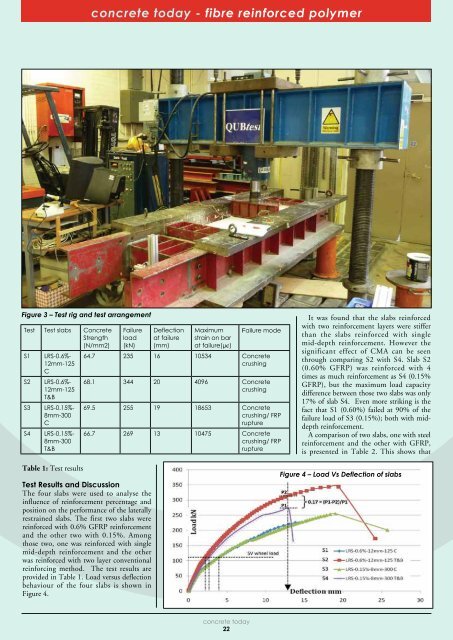Concrete Today May 2010 - the Irish Concrete Federation
Concrete Today May 2010 - the Irish Concrete Federation
Concrete Today May 2010 - the Irish Concrete Federation
Create successful ePaper yourself
Turn your PDF publications into a flip-book with our unique Google optimized e-Paper software.
concrete today - fibre reinforced polymer<br />
Figure 3 – Test rig and test arrangement<br />
Test Test slabs <strong>Concrete</strong><br />
Strength<br />
(N/mm2)<br />
S1<br />
S2<br />
S3<br />
S4<br />
LRS-0.6%-<br />
12mm-125<br />
C<br />
LRS-0.6%-<br />
12mm-125<br />
T&B<br />
LRS-0.15%-<br />
8mm-300<br />
C<br />
LRS-0.15%-<br />
8mm-300<br />
T&B<br />
Failure<br />
load<br />
(kN)<br />
Deflection<br />
at failure<br />
(mm)<br />
Maximum<br />
strain on bar<br />
at failure(µE)<br />
Failure mode<br />
64.7 235 16 10534 <strong>Concrete</strong><br />
crushing<br />
68.1 344 20 4096 <strong>Concrete</strong><br />
crushing<br />
69.5 255 19 18653 <strong>Concrete</strong><br />
crushing/ FRP<br />
rupture<br />
66.7 269 13 10475 <strong>Concrete</strong><br />
crushing/ FRP<br />
rupture<br />
It was found that <strong>the</strong> slabs reinforced<br />
with two reinforcement layers were stiffer<br />
than <strong>the</strong> slabs reinforced with single<br />
mid-depth reinforcement. However <strong>the</strong><br />
significant effect of CMA can be seen<br />
through comparing S2 with S4. Slab S2<br />
(0.60% GFRP) was reinforced with 4<br />
times as much reinforcement as S4 (0.15%<br />
GFRP), but <strong>the</strong> maximum load capacity<br />
difference between those two slabs was only<br />
17% of slab S4. Even more striking is <strong>the</strong><br />
fact that S1 (0.60%) failed at 90% of <strong>the</strong><br />
failure load of S3 (0.15%); both with middepth<br />
reinforcement.<br />
A comparison of two slabs, one with steel<br />
reinforcement and <strong>the</strong> o<strong>the</strong>r with GFRP,<br />
is presented in Table 2. This shows that<br />
Table 1: Test results<br />
Test Results and Discussion<br />
The four slabs were used to analyse <strong>the</strong><br />
influence of reinforcement percentage and<br />
position on <strong>the</strong> performance of <strong>the</strong> laterally<br />
restrained slabs. The first two slabs were<br />
reinforced with 0.6% GFRP reinforcement<br />
and <strong>the</strong> o<strong>the</strong>r two with 0.15%. Among<br />
those two, one was reinforced with single<br />
mid-depth reinforcement and <strong>the</strong> o<strong>the</strong>r<br />
was reinforced with two layer conventional<br />
reinforcing method. The test results are<br />
provided in Table 1. Load versus deflection<br />
behaviour of <strong>the</strong> four slabs is shown in<br />
Figure 4.<br />
Figure 4 – Load Vs Deflection of slabs<br />
concrete today<br />
22





